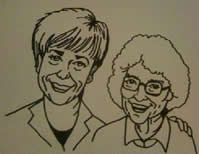People often ask for my opinion of the 5-star nursing home rating system that was instituted approximately two years ago by the Center for Medicare and Medicaid Service. The system is a comparative tool that assigns nursing homes composite rankings from 1 (below average) to 5 (above average). Rankings can be viewed on www.Medicare.gov. The scores are determined by a combination score based upon three items:
- The results from the annual inspection from the Illinois Department of Public Health
- Quality measures
- Staffing
I could probably write a book on this subject, but consider this newsletter to be a primer. While I think that the system may be helpful as part of the total evaluation of a nursing home, I would never use it as the sole criterion in making a decision. Let me share the reasons why:
Out of the three components that figure into the score, I consider the first one to be the most reliable. I was trained in a continuing care retirement community where the nursing home always received a perfect score on its inspection. A team of surveyors from the state arrives and may assign deficiencies to a home based on areas where it is weak. Categories that are inspected include housekeeping, residents’ appearance, medication errors, quality of care measures, and staffing history, just to name a few. However, the team of surveyors sent to a nursing home can vary. Some surveyors are going to be a lot tougher with their grading methods. The surveyors also arrive for the annual inspection at the same time every year (give or take a three-month window), which gives the facility’s staff enough time to correct flaws and prepare for their arrival. By the time a reader views the ranking, the findings on the survey may already be old. Also be advised that what is posted on the web site will be a vague summary of what the deficiency (“tag”) was for. You will not get the full story until you read the entire report, which is supposed to be displayed in the nursing home in a place where the public can read it. The average number of tags in Illinois is 8.
The quality measures component is reported by the nursing home staff, which I don’t consider to be 100% reliable. It is information that is collected about the home’s residents. Examples include how many residents received a flu shot last year, and the percentage of residents who have bedsores. The information collected reflects the conditions in the seven days prior to the assessment. It doesn’t take into account any changes that occur between report periods. The census may be made up of residents who are a lot older and more ill than at another home. That is like comparing an apple to an orange.
The staffing component is also reported by the nursing homes. Again, I don’t consider this to be reliable. Many of the homes staff for employees based upon the number and acuity of the residents living there at the time. So the staffing will undoubtedly vary.
I have little fear of using nursing homes that have received a rating of “1.” There have been times when a home hasn’t looked great based on a rating. However, they have proved to be proficient at handling clients with severe behavioral problems and complicated issues such as tracheotomies. There are other facilities that consistently receive high rankings. Yet upon repeat visits, I smell odors permeating the building, the residents are unkempt and unclean, and the staffing ratios have not been satisfactory.
There is no substitute for working with someone who will keep you apprised of the many important criteria that determine a good choice for your loved one. That’s where I can help out.

Real-Life Story
I was recently hired to help a family place their elderly Mother in a nursing home. The senior was 89 years old and living at home with her husband and a full-time caregiver. She had a diagnosis of Alzheimer’s disease, and was keeping the husband awake at night due to her sundowning (Sundowning is a condition where the person gets more agitated and confused in the late afternoon and early evening. It results in the homes having to keep the residents who have it on a very structured schedule to keep them busy and less agitated. It is theorized that darkness has something to do with it.) and pacing. She was also beginning to exhibit unacceptable behaviors, including lashing out at the husband. The caregiver’s fees were placing a strain on the family’s finances.
Because the husband was elderly, he needed to have his wife placed in a community that was nearby. He refused to drive on the highway, but wanted to be able to visit her on a daily basis.
I knew of an appropriate community that was within 10 miles of where they currently lived. The community had a special care Alzheimer’s unit that could accommodate her behaviors. They were also able to accommodate her future public aid needs. The nursing home had received a ranking of 1 on the Medicare.gov web site. However, I had placed a client in one of its other locations that was owned by the same individual. That client has received excellent care and the family has been satisfied. That community’s ranking was also a 1, based on the state’s limited ranking system.
My client has reported that on the date of their Mom’s move, the staff of the home was waiting to welcome her. The family commented that the staff was extremely compassionate and helped her become acclimated to her new home. This is a very tough period for a person with Alzheimer’s and her family. In my opinion, this home deserves 5 stars!
 Chicago Senior Living Advisors Blog
Chicago Senior Living Advisors Blog

